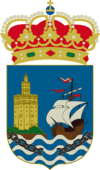Comillas
| Comillas | |||
|---|---|---|---|
| Municipality | |||
|
Building of Comillas Pontifical University | |||
| |||
_Mapa.svg.png) Location of Comillas | |||
 Comillas Location in Spain | |||
| Coordinates: 43°23′13″N 4°17′22″W / 43.38694°N 4.28944°WCoordinates: 43°23′13″N 4°17′22″W / 43.38694°N 4.28944°W | |||
| Country |
| ||
| Autonomous community |
| ||
| Province | Cantabria | ||
| Comarca | Western coast of Cantabria | ||
| Judicial district | San Vicente de la Barquera | ||
| Capital | Comillas | ||
| Government | |||
| • Alcaldesa | María Teresa Noceda Llano (2007) (PRC) | ||
| Area | |||
| • Total | 18.61 km2 (7.19 sq mi) | ||
| Elevation | 23 m (75 ft) | ||
| Highest elevation | 210 m (690 ft) | ||
| Lowest elevation | 0 m (0 ft) | ||
| Population (2008) | |||
| • Total | 2,483 | ||
| • Density | 130/km2 (350/sq mi) | ||
| Demonym(s) | Comillano, na | ||
| Time zone | CET (UTC+1) | ||
| • Summer (DST) | CEST (UTC+2) | ||
| Website | Official website | ||
Comillas is a small township and municipality in the northern reaches of Spain, in the autonomous community of Cantabria. The Marquisate of Comillas, a fiefdom of Spanish nobility, holds ceremonial office in the seat of power at a small castle which overlooks the town. The Comillas Pontifical University was housed here before it moved to Madrid, and the old university buildings are among the finest examples of architecture in the town. Besides this, there are many notable medieval and baroque buildings.
History
Comillas was first inhabited in prehistoric times when the caverns that are plentiful in the area were used as shelters. The Neolithic inhabitants left behind them rock paintings that depicted the animals they hunted.[1] Magdalenian and Bronze Age artefacts have been found in nearby Ruiseñada, and there was an ancient mine at La Molina in which utensils and Roman coins have been found as well as an altar dedicated to the god Jupiter.[2] Arrowheads have also been found here. On the border between Comillas and Ruiloba, heaps of shells have been found showing that the ancient people, besides hunting, specialised in collecting food from the sea.
The remains of the medieval castle of Peña del Castillo are still visible and another castle later occupied the same strategic site. The earliest documents relating to the town date to the eleventh century, although most of them were destroyed later in a fire at the town hall. Garcilaso de la Vega built a tower on the coast to demonstrate the towns dominance in maritime affairs. After the conclusion of the Valles Lawsuit against the Duke of Infantado in 1581, Comillas became part of the Province of Nine Valleys, a judicial and administrative body. Historically, the town was one of four towns making up the Alfoz of Lloredo. The town is sometimes known as the "Town of the Bishops", because five priests who were born here went on to become bishops in several different dioceses during the Middle Ages.[3]
Early in the twentieth century, the first marquis Antonio López y López invited King Alfonso XII to his mansion at Comillas and the town became popular with the aristocracy; the architect Joan Martorell built the enormous Palacio de Sobrellano on the instructions of the marquis.[4]
Geography
Comillas is situated close to the coast in the autonomous community of Cantabria. To the north lies the Bay of Biscay and to the south the Cantabrian Mountains which run parallel with the coast, the highest point of which is the Torre de Cerredo, 2,648 metres (8,688 ft). Santander lies fifty kilometres to the east. There is a sandy beach and headlands and the town is set a little way back from the sea.[5]
Buildings
The Plaza del Corro de Campios, in the centre of the oldest part of the town, is surrounded by ancestral mansions with shields on the walls depicting the noble families who lived there. The town hall and the seventeenth century parish church of San Cristóbal are nearby,[3] and there are some interesting mausoleums in the cemetery. The Neo-Gothic university buildings overlook the town.[6] The Art Nouveau buildings are some of the finest in Cantabria and include the Sobrellano Palace Chapel, the Pantheon, and El Capricho, a fantastic creation by the Catalan architect Antoni Gaudí.[7]
Marquis of Comillas

The first Marquis of Comillas was Antonio López y López (died 1883). Founder and owner of the Compañía Transatlántica Española, he was born in Comillas in 1817 and made his money in Cuba in shipping and slaves. He bought the title in 1878.[8] The second Marquis of Comillas was his son Claudio López Bru. The current Marquis of Comillas is Don Alfonso Güell y Martos.
Gallery
 Entrance to the Pontificial University, Comillas, Cantabria
Entrance to the Pontificial University, Comillas, Cantabria El Capricho, a building by Antoni Gaudí
El Capricho, a building by Antoni Gaudí Band of pipers playing in Comillas, Cantabria. Palace of Sobrellano at the background.
Band of pipers playing in Comillas, Cantabria. Palace of Sobrellano at the background.- Beach and port
- Harbour
References
- ↑ Bernard Samuel Myers (1959). Encyclopedia of world art. McGraw-Hill. p. 38.
- ↑ PACT. Conseil de l'Europe, Council of Europe. 1990. p. 130.
- 1 2 "Heritage in Comillas, Cantabria". Tourism Comillas. Retrieved 2015-08-30.
- ↑ DK Eyewitness Travel Guide: Northern Spain: Northern Spain. Dorling Kindersley Limited. 1 May 2013. p. 104. ISBN 978-1-4093-3105-6.
- ↑ Philip's Modern School Atlas. George Philip & Son. 1973. p. 37. ISBN 0-540-05278-7.
- ↑ Greenwood, Margaret (1992). The Footloose Guide:Spain. Simon & Scuster. p. 259. ISBN 0-671-71023-0.
- ↑ "The Town of Comillas: Cantabria". Tourism Comillas. Retrieved 2015-08-30.
- ↑ Dana Facaros; Michael Pauls (1 March 2009). Northern Spain. New Holland Publishers. p. 203. ISBN 978-1-86011-395-6.
External links
| Wikimedia Commons has media related to Comillas (Cantabria). |


